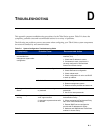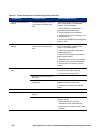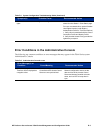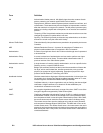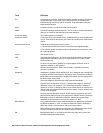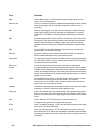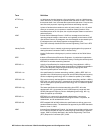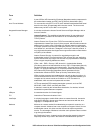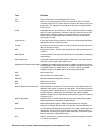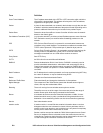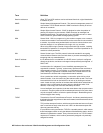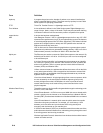Term Definition
HTTP Proxy An Web server that sits between a client application, such as a Web browser,
and a real server. It intercepts all requests to the real server to see if it can fulfill
the requests itself. If not, it forwards the request to the real server. Proxy servers
have two main purposes: improving performance and filtering requests.
Hub A piece of hardware that contains a series of ports (usually 4, 8, or 16), which
allow you to network your computers or extend an existing network. Hubs
broadcast packets to all of its ports, but only the computer meant to receive the
packet accepts it.
ICMP Internet Control Message Protocol - ICMP is a message control and error-
reporting protocol between a host server and a gateway to the Internet. ICMP
uses Internet Protocol (IP) datagrams, but the messages are processed by the
IP software and are not directly apparent to the application user.
The ICMP is formally described in the Internet Engineering Task Force‘s RFC
792.
Identity Profile A named set of user or network equipment grouped together for purposes of
sharing the same Connection Profile or Access Policy
Identity Profiles were called groups in previous versions of the 700wl Series
system.
IEEE Institute of Electrical and Electronics Engineers - A professional organization
that develops standards for the computer industry, including the commonly used
IEEE 802.11b wireless networking standard.
IEEE 802.11 A family of specifications for wireless networking, first published in 1997 by
IEEE. The original specification allows for speeds up to 2 Mbps and operates in
the 2.4-GHz frequency range using both frequency hopping and direct
sequence spread spectrum technologies.
IEEE 802.11a One specification for wireless networking, ratified in 1999 by IEEE. 802.11a
operates in the 5-GHz frequency range and uses OFDM (orthogonal frequency
division multiplexing) technology. 802.11a allows for speeds up to 54 Mbps.
IEEE 802.11b The most commonly used standard for wireless networking, ratified in 1999 by
IEEE. 802.11b, also known Wi-Fi, operates in the 2.4-GHz frequency range and
uses direct sequence spread spectrum technology. 802.11b allows for speeds
up to 11 Mbps.
IEEE 802.11g The latest specification for wireless networking from IEEE, still under
development. 802.11g operates in the 2.5-GHz frequency range and uses
OFDM (Orthogonal Frequency Division Multiplexing) technology. 802.11g
allows for speeds up to 54 Mbps.
IEEE 802.1x IEEE 802.1x is a protocol for port-based authentication. It structures
authentication as a process between three logical entities: a requester, an
authenticator, and an authentication server.
IEEE 802.3af IEEE standard 802.3af-2003 defines the specifications to deliver power over
standard Ethernet cables. The standard was approved by the IEEE Standards
Board on June 12, 2003
IGMP Internet Group Management Protocol - An Internet protocol that provides a way
for an Internet computer to report its multicast group membership to adjacent
routers. IGMP is formally described in the Internet Engineering Task Force
(IETF) Request for Comments (RFC) 2236.
HP ProCurve Secure Access 700wl Series Management and Configuration Guide E-5



